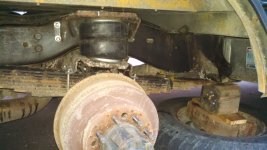PathNotTaken
Member
Trying to get some opinion on stiffening the frame of an expedition camper, which I get the impression many on this forum think is a bad idea. For reference, this is for a relatively short wheelbase E350. The plan is to have the cab rigidly mounted to the habitat, with springs of varying rate rearward to allow for frame flex. With that said, the frame will obviously still transmit some load to the subframe. While I'm confident the subframe will handle this, I'm wondering what the downsides are of just directly reinforcing the frame.
The rear of the frame will already be reinforced by the beefy rear bumper that will hold the tow hitch. What is the downside of bolting another cross member, potentially more towards the front to relieve stress from the cab-habitat interface? My understanding is that this would be effectively no different than the stiffness added by the subframe, but stronger and better placed. Thoughts?
The rear of the frame will already be reinforced by the beefy rear bumper that will hold the tow hitch. What is the downside of bolting another cross member, potentially more towards the front to relieve stress from the cab-habitat interface? My understanding is that this would be effectively no different than the stiffness added by the subframe, but stronger and better placed. Thoughts?





